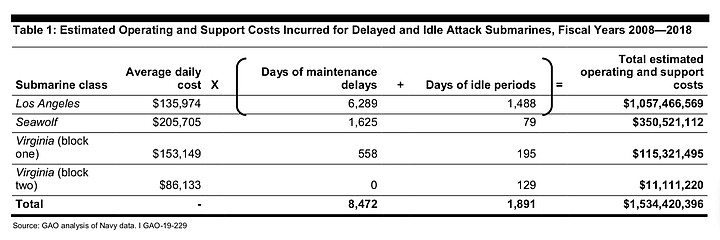 Facebook
Facebook
 X
X
 Instagram
Instagram
 TikTok
TikTok
 Youtube
Youtube

The Navy's fleet of 51 attack submarines, a portion of which is based in San Diego, is suffering from a series of "significant maintenance delays and operating and support cost expenditures," that could jeopardize the national defense, according to an audit by the U.S. Government Accountability Office.
"Between fiscal year 2008 and 2018, attack submarines have incurred 10,363 days of idle time and maintenance delays as a result of delays in getting into and out of the shipyards," says a newly-released public version of the classified November 16 report to Congress.

Since 2008, the document adds, the Navy has spent more than $1.5 billion "to support attack submarines that provide no operational capability—those sitting idle while waiting to enter the shipyards, and those delayed in completing their maintenance at the shipyards."
Some of the hold-up has been caused by the need to comply with additional safety standards required due to risks of undersea operations, the document says. "The Navy will delay deployment dates if necessary to ensure that these standards are met. As a result, deployed readiness is high and attack submarines are in excellent materiel condition as compared with the rest of the Navy fleet."
But in the meanwhile, extended repair times have grown ever costlier.
"We found that since Fiscal Year 2008, 14 attack submarines have spent a combined 61 months idling while waiting to enter shipyards for maintenance. Idle time incurred while waiting to begin a maintenance period is often coupled with maintenance delays while at the shipyards, thus compounding total delays."
"Operating and support costs include payment of crew salaries, purchasing of spare parts, and conducting of maintenance, among other things, but they do not represent the full operational impact incurred by the Navy from the idle time and maintenance delays."
And the situation isn't improving, auditors say.
"While the public shipyards have operated above capacity for the past several years, attack submarine maintenance delays are getting longer and idle time is increasing. The Navy expects the maintenance backlogs at the public shipyards to continue."
"We estimate that, as a result of these backlogs, the Navy will incur approximately $266 million in operating and support costs in Fiscal Year 2018 constant dollars for idle submarines from Fiscal Year 2018 through Fiscal Year 2023, as well as additional depot maintenance delays."
The audit calls for better sharing of work between the so-called public shipyards – those run by the government – and private contractors. "Although the Navy has shifted about 8 million man-hours in attack submarine maintenance to private shipyards over the past 5 years, it has done so sporadically, having decided to do so in some cases only after experiencing lengthy periods of idle time."
"According to private shipyard officials, the sporadic shifts in workload have resulted in repair workload gaps that have disrupted private shipyard workforce, performance, and capital investment — creating costs that are ultimately borne in part by the Navy."
In its November 14 response, the Pentagon agreed to improve the way it allocated business between government shipyards and private contractors. "The Department of Defense concurs with this recommendation and has taken the first steps to take a more holistic view of submarine maintenance requirements and impacts across both the public and private shipyard."
Per the audit, "attack submarines are homeported at bases in the United States: in New London, Connecticut; Pearl Harbor, Hawaii; Norfolk, Virginia; San Diego, California; and Bangor, Washington; 4 are homeported overseas, in the U.S. territory of Guam."


The Navy's fleet of 51 attack submarines, a portion of which is based in San Diego, is suffering from a series of "significant maintenance delays and operating and support cost expenditures," that could jeopardize the national defense, according to an audit by the U.S. Government Accountability Office.
"Between fiscal year 2008 and 2018, attack submarines have incurred 10,363 days of idle time and maintenance delays as a result of delays in getting into and out of the shipyards," says a newly-released public version of the classified November 16 report to Congress.

Since 2008, the document adds, the Navy has spent more than $1.5 billion "to support attack submarines that provide no operational capability—those sitting idle while waiting to enter the shipyards, and those delayed in completing their maintenance at the shipyards."
Some of the hold-up has been caused by the need to comply with additional safety standards required due to risks of undersea operations, the document says. "The Navy will delay deployment dates if necessary to ensure that these standards are met. As a result, deployed readiness is high and attack submarines are in excellent materiel condition as compared with the rest of the Navy fleet."
But in the meanwhile, extended repair times have grown ever costlier.
"We found that since Fiscal Year 2008, 14 attack submarines have spent a combined 61 months idling while waiting to enter shipyards for maintenance. Idle time incurred while waiting to begin a maintenance period is often coupled with maintenance delays while at the shipyards, thus compounding total delays."
"Operating and support costs include payment of crew salaries, purchasing of spare parts, and conducting of maintenance, among other things, but they do not represent the full operational impact incurred by the Navy from the idle time and maintenance delays."
And the situation isn't improving, auditors say.
"While the public shipyards have operated above capacity for the past several years, attack submarine maintenance delays are getting longer and idle time is increasing. The Navy expects the maintenance backlogs at the public shipyards to continue."
"We estimate that, as a result of these backlogs, the Navy will incur approximately $266 million in operating and support costs in Fiscal Year 2018 constant dollars for idle submarines from Fiscal Year 2018 through Fiscal Year 2023, as well as additional depot maintenance delays."
The audit calls for better sharing of work between the so-called public shipyards – those run by the government – and private contractors. "Although the Navy has shifted about 8 million man-hours in attack submarine maintenance to private shipyards over the past 5 years, it has done so sporadically, having decided to do so in some cases only after experiencing lengthy periods of idle time."
"According to private shipyard officials, the sporadic shifts in workload have resulted in repair workload gaps that have disrupted private shipyard workforce, performance, and capital investment — creating costs that are ultimately borne in part by the Navy."
In its November 14 response, the Pentagon agreed to improve the way it allocated business between government shipyards and private contractors. "The Department of Defense concurs with this recommendation and has taken the first steps to take a more holistic view of submarine maintenance requirements and impacts across both the public and private shipyard."
Per the audit, "attack submarines are homeported at bases in the United States: in New London, Connecticut; Pearl Harbor, Hawaii; Norfolk, Virginia; San Diego, California; and Bangor, Washington; 4 are homeported overseas, in the U.S. territory of Guam."
Comments